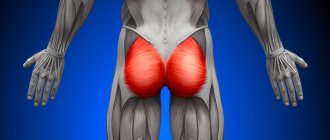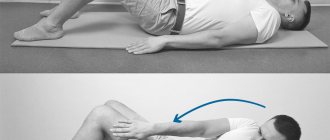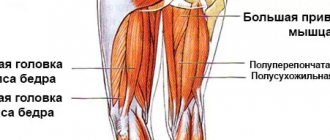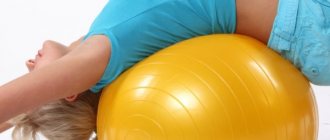Despite the fact that in sports the transverse abdominal muscle is almost never singled out as an object for pumping, it has an incredible impact not only on physical fitness, but also on human health. The stabilization of the spine and the correct location and functioning of the internal organs depend on it. Moreover, exercises for the transverse abdominal muscle are not always present in the training program, which leads to insufficient load and weakening. Understanding the anatomical features, structure and exercises necessary for pumping will strengthen the tone, as well as eliminate many problems and health risks.
Anatomy and function of the transverse abdominis muscle
Anatomically, the transverse abdominal muscle belongs to the deep muscles (3rd layer). Located directly under the inner braid (2nd layer). Presented in the form of a thin plate with transversely directed beams.
The transverse abdominal muscles are covered with their own fascia. They originate from:
- The inner surface of the 7-12 ribs (due to the introduction of teeth into the muscular part of the diaphragm).
- Inner lip of the iliac crest.
- Inguinal ligament (lateral third).
- Lumbothoracic fascia.
Attached to the linea alba.
The main function of the transverse abdominis muscle is to pull the ribs towards the midline, thereby maintaining the natural position of the internal organs.
Why train the transverse abdominis muscle?
From a health perspective, not a sporting one, it is one of the most important structural elements of the abdominal muscles. However, everyone needs to train the transverse abdominal muscle, regardless of their occupation. In addition to holding the organs, the ability to maintain a straight body position directly depends on its tone. Also, training the transverse abdominal muscle is one of the best types of hernia prevention, especially for people who lead a sedentary lifestyle or have a sedentary job.
If we highlight the main reasons for which we should pump up the transverse abdominal muscle, we should note:
- Visual reduction of the abdomen and improvement of tone.
- Prevention of hernias.
- Maintaining organs in their natural position.
- Improving abdominal function.
- The ability to maintain a straight body position for a long time without fatigue and “bending” forward.
For women, exercises for the transverse abdominal muscle are one of the fastest and most effective ways to make your waist thinner.
“Vacuum in the stomach” - standing on all fours
vacuum in the stomach while standing
It is done as follows: you need to stand straight, spreading your legs shoulder-width apart. While inhaling deeply, bend your body slightly forward and bend your knees. Then all the air from the lungs is exhaled, and at this time the stomach is drawn inward as much as possible. To perform this exercise correctly, you need to monitor the position of your head.
The head should be slightly tilted down, as if you want to press your chin to your chest, but you should not look at the floor, but straight. It is this position that prevents air from entering the lungs. In addition, your back should be perfectly straight while performing the exercises. If done correctly, you will feel like your internal organs are slightly rising towards your ribs. Essentially, this is what happens. Hold your stomach in a retracted position for at least 20 seconds, slowly relax it, restoring your breathing.
Also, the vacuum exercise, the technique of which remains the same in any position of the body, can be performed while standing on all fours or sitting.
The simplest type of technique is an exercise performed lying down with bent knees.
1. Starting position - lying on your back, arms along the body, legs bent at the knees, standing on the floor, muscles relaxed. Exhale slowly, gradually emptying your lungs of air, without straining any muscles in your body.
2. Having freed your lungs from air, begin to tense your abdominal muscles, trying to draw it in as much as possible. Breathing stops. At the lowest point, fix the position of your stomach for 10 - 15 seconds, then take a small breath, continuing to draw in your stomach.
3. After taking a small breath, do not rush to relax your stomach - tighten your abdominal muscles and freeze for another 10 - 15 seconds, then pull your stomach in again, while maintaining tension in your abdominal muscles. If you find it difficult to hold your breath, take small breaths.
4. Exhale, relax your stomach, take a few free breaths and exhales, then empty your lungs of air again and pull your stomach in as much as possible. As you pull in, try to tighten your abdominal muscles, and then push your stomach up without inhaling.
Advantages :
- getting rid of a distended abdomen (its prolapse forward), which occurs due to underdeveloped transverse abdominal muscles;
- reducing the visceral layer of fat surrounding the internal organs;
- significant narrowing of the waist in a short period of time;
- visual enlargement of the chest;
- development of strength of the transverse abdominal muscles;
- a flat stomach without fear of pumping up your abs;
- helps stabilize the spine and reduce pain in the lower back;
- prevents prolapse of internal organs;
Recommendations
Experienced athletes recommend exercising in the morning and evening, when the body is most receptive to physical activity. In the first week of mastering the technique, it is enough to perform exercises for 15 minutes, gradually increasing the training time to 30 minutes. Exercises can be alternated with cardio or strength training. The number of repetitions is purely individual - repeat the exercises until you feel that it is difficult for you to completely exhale the air.
Contraindications
However, despite its enormous usefulness, the vacuum exercise for a flat stomach also has its contraindications - you should not practice it if you have a stomach or duodenal ulcer, on “critical” days and during pregnancy. This exercise must be performed with extreme caution in case of any diseases of the lungs, stomach and heart muscle.
In addition to losing weight and pumping up abdominal muscles, vacuum exercises heal the body. For example, in yoga it is believed that it rejuvenates the nerves of the gastric tract and intestines, promotes the elimination of toxins, strengthens the back muscles, which has a good effect on posture, massages the internal organs, and also rejuvenates the internal glands.
Workout Features
The main problem is that standard abdominal exercises that are popular in fitness do not engage the transverse muscle. This is precisely the reason that even with trained external muscles, the overall aesthetics of the torso is far from ideal (the stomach protrudes, the waist visually becomes larger).
The second problem is the correct preparation of the training program. There are two main ways to work out the target zone:
- After basic abdominal exercises.
- On a separate day.
It is much more effective to allocate a separate day for pumping. This will ensure that it is loaded so that the external parts of the press do not take on most of the load. If you have no time at all, you can train it after the main abdominal block. In this case, the outer muscles will already be tired, which will provide the necessary tension for the inner layer.
To work effectively, it is enough to allocate no more than 2 short sessions per week, but only between meals (so that the stomach is empty).
The best exercises for the transverse muscle
An important condition for effectively pumping the transverse abdominal muscle is muscle concentration. Without it, even the most effective movements will not bring any benefit, since the load will be taken by the muscles of the outer layer. Therefore, during the period of mastering the technique, it is recommended to simultaneously improve muscle control.
Exercise "Vacuum"
It is generally accepted that a “vacuum” gives “wonderful abs” and it was this that became the key to Arnold Schwarzenegger’s ideal waist. Modern sports research proves that vacuum is almost useless for the outer layer. However, it is best suited for deep abdominal areas. It is considered the most effective exercise for the transverse abdominal muscle for men.
Technique:
- Stand up straight. Hands down, feet shoulder-width apart. The back is straight.
- Take a powerful breath and push your abdominals forward (using your muscles).
- After 1-2 seconds of tension, exhale powerfully, pulling your stomach towards your ribs as much as possible.
- Hold the position for 3-5 seconds, then inhale and repeat the movement.
It is optimal to perform 7-10 breaths per workout. It is not the number of repetitions that is important, but the force of exhalation and the muscle tension that you can hold. It is also strictly not recommended to increase the time you hold your breath. This can have a detrimental effect on blood vessels and even lead to loss of consciousness. The main method of progression is muscle tension and the number of inhalations/exhalations in a series (no more than 15 per workout).
Plank exercise
Despite the fact that the plank is often criticized for its low effectiveness for the abs (oblique and straight), for the inner layers this is one of the most useful exercises.
Technique:
- Take a lying position, as for push-ups. Press your toes and your entire forearm into the floor (located parallel to each other). There is a right angle at the elbow, the body forms a single straight line from the neck to the heels.
- Maintain your current position for as long as possible.
Beginners are advised to hold the position for up to 30-40 seconds. Advanced athletes – from 60 to 90 seconds. A plank for more than one and a half minutes is considered ineffective, since in order to stabilize the position, the load will “go” to other groups.
Pelvic bridge
A great move, but only if done with the right style. The classic power bridge version is not suitable for this task. The movement should be performed without weight, with a delay at the peak point of up to 4-5 seconds.
Technique:
- Lie on the floor, place your arms along your body. Bend your legs at the knees.
- Lift your pelvis off the floor and lift it so that your body forms a straight line from your knees to your shoulders.
- Hold this position for 3-5 seconds, while concentrating tension (while exhaling).
It is important to make the bridge so that the shoulder blades lie on the floor. The option of resting on a bench is not suitable in this case.
"Vacuumization"
It is one of the main and basic exercises. Although it is most comfortable to do while lying on your back, it can also be done standing or even while walking.
- First you need to stand up straight and place your feet shoulder-width apart;
- Next, take a very deep breath and try to push your stomach forward;
- Then exhale all the air from your lungs with force, and at the maximum level, try to draw your stomach in, imagine that you want to touch your spine. In this position you need to freeze for literally a few seconds.
- Then inhale and relax your abdominal muscles, trying to push it forward as much as possible.
Repeat all this about 8-10 times , then rest a little and do this complex about 8-10 more times. Don't push yourself too hard, do it gradually. You need to hold your breath in these positions for 3 seconds. Then, gradually increase the load.
Notes for the exercise:
- Inhalation and exhalation should be done with tension and as deeply as possible. However, do not overdo it, you should increase the load gradually so that the body gets used to it.
- The first results when pumping the transverse muscle will appear only after a month. And at the moment they will consist only of deeper retraction, and only then aesthetic and beautiful abs.
Here's a travel video about the vacuum for more information. Be sure to watch if you are concerned about the problem of a flat stomach:










